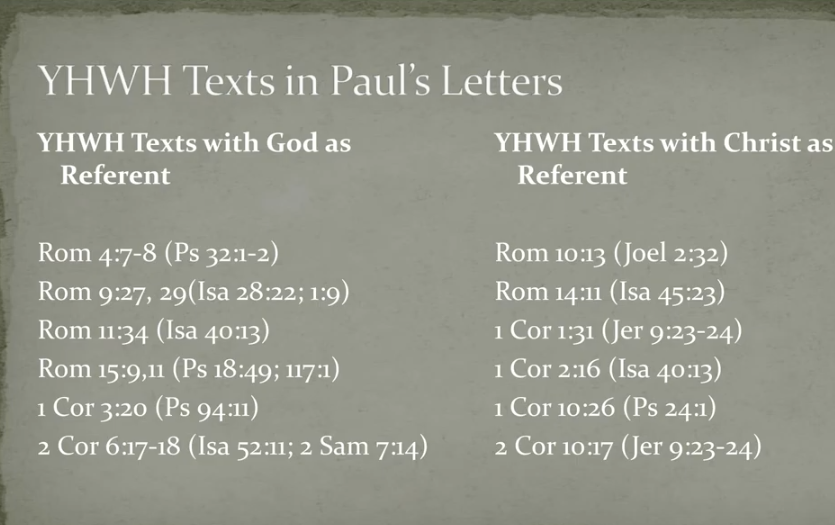- This topic has 963 replies, 25 voices, and was last updated 3 years, 11 months ago by
Berean.
- AuthorPosts
- June 11, 2021 at 4:03 am#871399
 gadam123Participant
gadam123ParticipantAdam…..Very good post brother, I just wonder, could it be that In order to see God , we would have to come out side of him ( and because life is what God is) so that would mean we would have to come outside of him, and we would have to die, in order to achieve that?
I am more and more convinced, God is what life “itself” is. Remember what Paul said, “know you not your “body” is the temple of the living God. God being “in All and through ALL, is the “tree of life” which is God. He is referred to as the, “TREE” ( that which brings forth from “SELF” ) . So life “itself” is what, God is. So with that view, everything that has life has God “in” it.Another words we “all live, and have our being “in” God. Just food for though brother.
There is life because , life is what God actually is.
It’s really interesting the way you simplify the secret of finding God. In India we hear the same in our ancient religion stating that God is every where and in every thing. If you want to really meet him it is through relinquishing this form of life and reach the ultimate source of life ‘Parmatma’. It’s called this Atma (soul) strives to meet Parmatma (God) and this climax is called Moksha (Salvation). In Hebrew religion too the spirit of man leaves the body at his death and meets its ultimate source God. And that is the climax of this life. In fact there is no after life in the primitive Hebrew religion but it was developed later stage especially after the return of the Exiles from Babylon, most probably after third Century BCE.
Christianity changed every thing about God and the existence of life. A full blown afterlife called eternal life, Heaven & Hell and much more. We need to do more research on these developments on this religion.
Thanks and peace to you….Adam
June 11, 2021 at 4:45 am#871400 gadam123Participant
gadam123ParticipantWho is a liar but he that denieth that Jesus is the Christ? He is antichrist, that denieth the Father and the Son.
[23] Whosoever denieth the Son, the same hath not the Father: (but) he that acknowledgeth the Son hath the Father also. 1John 2:22,23This was a far cry from these writers to defend the new religion from the Jewish hardliners because they had to necessarily include this additional (divine) being within Jewish Monotheism. But they could not gather much crowd and finally they had to look to Gentile population to find many takers for this new religion…IMO
June 11, 2021 at 4:48 am#871401 Danny DabbsParticipant
Danny DabbsParticipantHi Gene,
You are calling Adam your brother, knowing that He denies
that Jesus is the Messiah?
You are a wolf, Gene!June 11, 2021 at 5:51 am#871402 Danny DabbsParticipant
Danny DabbsParticipantAmen Berean
June 11, 2021 at 8:37 am#871403 ProclaimerParticipant
ProclaimerParticipantFirst of all I am not a Trinitarian
Read my post again. I’ll state it in another way. You have both bought into this doctrine as being what the New Testament teaches. This has caused you to reject the New Testament and has caused LU to believe it, despite it coming from Babylon.
There are exactly zero scriptures in either testament that teach the Trinity or that Jesus is God.
June 11, 2021 at 9:06 am#871404Berean
ParticipantProclaimer
There are exactly zero scriptures in either testament that teach the Trinity or that Jesus is God.
I suppose you mean that Jesus is not the Most High God but that being his only begotten Son, He is God in essence by inheritance from the Father (John 1: 1)
And the Word WAS GOD.June 11, 2021 at 11:05 am#871406 ProclaimerParticipant
ProclaimerParticipantHi Berean. Even of one partakes in divine nature or has divine nature, that doesn’t make you or anyone else God.
Yes God has divine nature. God is also light and Jesus is the light. But scripture clearly teaches that we Believers are the light too.
God is spirit right? But Angel’s are spirits too.
You cannot define anyone as being God by their nature or character alone. God is God because that is WHO He is. He is the person who has always existed and the creator of all. It is he who shares his nature and distributes his attributes among the living and even makes us after such things.
As for John 1:1, please click this:
June 11, 2021 at 2:32 pm#871407 LightenupParticipant
LightenupParticipantYou say:
Greek sentence construction affirms that if a noun doesn’t have a preceding article, (THE) it can be read as an adjective (a predicate adjective); and if such a noun does have a preceding article it should be considered a noun (a predicate nominative).
Please tell me what your source is for the above.
June 11, 2021 at 3:00 pm#871408 LightenupParticipant
LightenupParticipantHi Adam,
You said:
I always like your positive attitude. Yes the NT certainly talks the divinity of Jesus.
Thank you. The identity of YHVH as applied to Jesus is certainly in the NT.
 June 11, 2021 at 3:02 pm#871409
June 11, 2021 at 3:02 pm#871409 LightenupParticipant
LightenupParticipantYou said:
Read my post again. I’ll state it in another way. You have both bought into this doctrine as being what the New Testament teaches.
You do not know what the trinity doctrine teaches for you to say this. The Holy Spirit is a third person in that doctrine. When have I said that the NT teaches this?
June 11, 2021 at 3:06 pm#871410 LightenupParticipant
LightenupParticipantRegarding this:
I think we are having a communication issue. Your post about plurals and singulars compare the word like “sheep” which is spelled the same way whether it is singular or plural, with the word “theos” and then go on to say how theos is plural in John 10:34. It is true that the root word of “theos” is translated as plural in John 10 but your post does not reflect that the word in John 10:34 is spelled “theoi.” Therefore, the root word “theos” is not like sheep that is spelled the same way whether it is singular or plural. The spelling of the word changes to indicate if it is plural or singular and should not be in your list here:
Words with both singular and plural usage
sheep;
cattle;
deer;
fish;
trout;
salmon;
aircraft;
spacecraft;
tsunami;
elohim;
theos.Can you see that “theos” does not fit this list?
Can you now admit that theos does not fit your list?
June 11, 2021 at 3:12 pm#871411 gadam123Participant
gadam123ParticipantTwo Powers in Heaven ?
Among the most popular clichés not only in Jewish and Christian theology but also in popular religious belief is the assumption that Judaism is the classic religion of monotheism, and if Judaism did not in fact invent monotheism, then it at least ultimately asserted it. Nothing summarizes this basic assumption better than the affirmation in Deuteronomy 6:4: “Hear, O Israel:
The Lord is our God, the Lord is one.” As the Shema‘ Yisrael,
it became the solemn daily prayer, with which many Jewish martyrs went to their death. Christianity, as this narrative continues, adopted this Jewish monotheism, but quickly expanded it with the idea of the incarnation of God’s son, the Logos, and finally watered it down entirely with the doctrine of three divine persons, the Trinity. In this view, Judaism was thus compelled to limit itself even more to the abstract concept of the one and only God.
This God could then easily degenerate into the caricature of the Old Covenant’s God, who receded ever farther into the distance and against whom the message of the New Covenant could set itself apart with all the more radiance. Judaism, according to this narrative, had no alternative but to assume its assigned role, as there was never a serious, much less balanced dialogue between mother and daughter religion.
The term “monotheism” is a modern coinage, first documented in 1660 by the English philosopher Henry More, who used it to characterize the ideal pinnacle of faith in God. Well into the twenty first century the term continued to play a key role in two opposing models of development of religions: either monotheism was considered the unsurpassable end point in a long chain of religions, which at the dawn of time began with all kinds of “primitive” forms, in order then to be spiritualized in increasingly “pure” forms (the evolutionary model), or on the contrary, it was the original ideal form of religion, which over time continued to degenerate and ultimately lost itself in polytheistic diversity (the decadence model). Both
models have long since become obsolete in religious history. Monotheism is neither at the beginning of “religion” nor does it represent the final apex of a linear development. What makes more sense is a dynamic model that dispenses with value judgments, and moves between the two poles of “monotheism” and “polytheism,” including numerous configurations and combinations that crystallized at different times and in different geographic regions.This also means that Jewish monotheism was not “achieved” at a certain point in time in the history of the Hebrew Bible, in order thereafter only to be defended against attacks from “the outside.” This linear developmental model is also outdated. Bible scholars today paint a multifaceted picture of the idea of God in ancient Israel, in which various gods stand side by side and compete with one another. Israel’s own God YHWH had to assert himself not only against numerous powerful spirits and demons but especially also against the deities of the Ugaritic and Canaanite pantheon, headed by the old god El and his subordinate, the young war god Ba‘al. The strategy of the authors and editors of the Hebrew Bible to let competing gods be subsumed in YHWH was not always successful. Ba‘al worshippers proved to be particularly resistant to this, as shown by the confrontation of the prophet Elijah against the cult of Ba‘al, as demanded by King Ahab in the ninth century BCE (1 Kings 18). The prophet Hosea still felt compelled in the eighth century BCE to take action against the Ba‘al worship at the land’s high places (Hos. 2).
The ideal of biblical monotheism becomes utterly problematic if we take into account how easily a consort was long associated with the biblical God. The inscriptions of Kuntillet Ajrud near the road from Gaza to Eilat, from the time of the Kingdom of Judah, mention YHWH as the God of Israel together with his
Asherah. This Asherah is a well-known Canaanite goddess, also documented in the Bible as the wife of Ba‘al (1 Kings 18:19). Her cultic image was worshipped in the Kingdoms of Judah and Israel, and was even displayed by King Manasseh in the YHWH Temple in Jerusalem. The biblical narratives that report triumphantly of the successful destruction of these idols cannot conceal the fact that this cult continued to be widespread, and was revived time and again. Even regarding the fifth century BCE, we hear of Jewish mercenaries who settled in the Egyptian border fortress Elephantine and not only built their own temple there (despite the allegedly one-and-only sanctuary in Jerusalem) but in addition to their God Yahu (YHW), also worshipped two goddesses—and this continued for more than two hundred years without the Temple congregation in Jerusalem being able or inclined to take action against it.The conflict between a theology that wished to acknowledge only YHWH as God and a religious tradition with many goddesses and gods came to a head in the crisis triggered by the Babylonian exile. While the “angel of the Lord” (Exod. 23:20–33), who is in competition with YHWH and would play a large role in rabbinic commentaries, has been placed by Bible scholarship in an earlier layer in the Hebrew Bible, the indefinite plural in the first story of creation—“Then God said, ‘Let us make humankind in our image, according to our likeness” (Gen. 1:26)—is part of the priestly account, which was probably written during the exile. For this reason, the priestly account of creation may well imply a “monotheistic confession,” despite the use of a plural from the mouth of the same God, but this confession, as the rabbis experienced during the confrontation with their Christian, Gnostic, or also inner-Jewish opponents, was anything but uncontested. The same is true for the apocalyptic as well as the wisdom literature of postexilic Judaism of the Second Temple, both belonging to the canonical and especially also noncanonical literature. This is not simply a matter of an angelology, which places itself, as a “buffer” as it were, between the ostensible “distance of a God becoming increasingly transcendent” and his earthly people, Israel, yet more directly and tangibly, it is about the return of not many but at least two gods in the Jewish heaven.
No less problematic about the ideal picture sketched above are the roles assigned to Christianity and the rabbinic Judaism that was becoming established at the same time. There is no doubt that the Christianity of the New Testament and the early church fathers of the first centuries CE adopted Jewish monotheism—
however, it was not a “pure” monotheism matured to eternal perfection but rather the “monotheism” that had developed in the postexilic period in the later canonical literature of the Hebrew Bible and noncanonical writings, the so-called apocrypha and pseudepigrapha. The New Testament took up these traditions that existed in Judaism, and did not reinvent but instead expanded and deepened them. The elevation of Jesus of Nazareth as the firstborn before all creation, the God incarnate, Son of God, Son of
Man, the Messiah: all these basic Christological premises are not pagan or other kinds of aberrations; they are rooted in Second Temple Judaism, regardless of their specifically Christian character. This is not changed by the fact that the divine duality of father and son led, far beyond the New Testament, to the Trinity of Father, Son, and Holy Spirit, which would then be codified in the First Councils of Nicaea (325 CE) and Constantinople (381 CE).The Christological and then also the Trinitarian intensification of the concept of God in Christianity by no means implies that rabbinic Judaism forgot or repressed its own roots in Second Temple Judaism. Quite to the contrary. Recent research shows with increasing clarity that the Judaism of the first century CE
did not ossify in lonely isolation and self-sufficiency; rather, only through constant discourse with the evolving Christianity did it become what we refer to today as rabbinic Judaism and the Judaism of early Jewish mysticism. Just as Christianity emerged through recourse to and controversy with Judaism, so too the Judaism of the period following the destruction of the Second Temple was not a Judaism identical to that of its early precursors but instead developed in dialogue and controversy with Christianity.Therefore, I prefer to define the relationship between Judaism and Christianity not as linear from the mother to the daughter religion but rather as a dynamic, lively exchange between two sister religions—a process in which the delimitation tendencies steadily grew, leading ultimately to the separation of the two religions.
The title of this examination, based on the rabbinic phrase “two powers in heaven” (shetei rashuyyot), which clearly implies two divine authorities side by side. This does not refer to two gods who fight each other in a dualistic sense (“good god” versus “evil god”), as we are familiar with primarily from Gnosticism, but rather two gods who rule side by side and together—in different degrees of agreement and
correlation. Scholarship has developed the term “binitarian” to describe this juxtaposition of two powers or gods, analogous to the term “trinitarian” associated with Christian dogma.The theme of two divine authorities in the Jewish heaven is not new. Almost all pertinent studies follow the key rabbinic concept of “two powers,” concentrating on the period of classical rabbinic Judaism. After the pioneering work of R. Travers Herford, the revised dissertation of Alan Segal, Two Powers in Heaven, is considered a milestone in more recent research. Despite their indisputable merits, however, both works set out from the premise that the rabbis, in their polemics against “two powers,” were referring to clearly identifiable “heretic sects” that were beginning to break off from “orthodox” Judaism. For Herford, it was overwhelmingly Christianity that incurred the wrath of the rabbis, whereas Segal attempted to address an entire spectrum of pagans, Christians, Jewish Christians, and Gnostics. But ultimately, even Segal’s Two Powers in Heaven remains caught in the methodological straitjacket of dogmatically established “religions” that defended themselves against “sects” and “heresies.”
Since then, the binitarian traditions of ancient Judaism have increasingly moved into the spotlight of research, though with different premises for early and rabbinic Judaism. Research in the field of Jewish studies continues to concentrate primarily on the rabbinic Judaism that was gradually emerging and its confrontation with nascent Christianity.
Early Judaism—that is, the period prior to rabbinic Judaism and the New Testament—has up to now been examined predominantly by Christian New Testament scholars. With his seminal contribution on the Son of God, Martin Hengel opened up an entire field of research that has since gained considerable influence
especially in Anglo-Saxon research under the heading of “High Christology.” “High Christology” is understood as referring to the Christology of the New Testament that specifically addresses the divinity of Jesus, in contrast to “Low Christology,” which is primarily concerned with Jesus’s human nature. If the writings of the New Testament—that is, long before the later dogmatic statements by the church fathers—already speak of the idea of Jesus’s divinity and his being worshipped as a second God next to God the Father (which is generally affirmed), how does this relate to the supposed biblical and early Jewish monotheism?Our debate on “The Most High God” continues….
June 11, 2021 at 7:26 pm#871413Berean
ParticipantHi Proclaimer
Even of one partakes in divine nature or has divine nature, that doesn’t make you or anyone else God.
The Son of God has the same nature (physical and spiritual) as his Father:
“and who, being the reflection of his glory and the imprint of his person,” (Hebrews 1: 3)
This is why John says:
AND THE WORD WAS GOD
AND THAT IS WHY GOD CREATED EVERYTHING THROUGH HIS SON (NAMED THE WORD)
AND THEREFORE THE SON HAS THE SAME DIVINE ATTRIBUTES AS HIS FATHER WHOSE OMNIPOTENCESo “partakes in divine nature or has divine nature, “IS NOT THE SAME THING….
June 13, 2021 at 2:59 am#871416 GeneBalthropParticipant
GeneBalthropParticipantAdam…..The native Indians in America, believed in the “Great Spirit,” that was also in all creatures, the Eagle, the Buffalo, etc. I tend to believe that also, that God, who “is Spirit” is “in” all things that have life in them. Life is given by him and returns back to him, in him we have our “BENIG”. He is what life itself “IS” .
Peace and love to you and yours Adam……….Gene
June 13, 2021 at 4:33 am#871417 gadam123Participant
gadam123ParticipantAdam…..The native Indians in America, believed in the “Great Spirit,” that was also in all creatures, the Eagle, the Buffalo, etc. I tend to believe that also, that God, who “is Spirit” is “in” all things that have life in them. Life is given by him and returns back to him, in him we have our “BENIG”. He is what life itself “IS” .
Thank you brother Gene for sharing your experience with Native Indian religion in America. In fact Hebrew primitive religion had been much influenced by Hellenism and the same was taken over by Christianity with more Pagan ideas. I am only doing research on the primitive religion based on Hebrew Bible.
Peace and love to you…..Adam
June 13, 2021 at 4:43 am#871418 Danny DabbsParticipant
Danny DabbsParticipantJesus said to him, “I am the way, the truth, and the life. No one comes to the Father except through Me.
John 14:6June 13, 2021 at 4:47 am#871419Berean
ParticipantAmen Danny !
June 13, 2021 at 5:25 am#871420Berean
ParticipantRev.6
[1] And I saw when the Lamb opened one of the seals, and I heard, as it were the noise of thunder, one of the four beasts saying, Come and see.
[2] And I saw, and behold a white horse: and he that sat on him had a bow; and a crown was given unto him: and he went forth conquering, and to conquer.The white horse is the own emblem of the triumphs of the gospel in the first century of Christian history. It symbolized the Church of the Apostles, or Ephesus in Revelation 2: 1.
The testimony of the first apostles is trustworthy.
Gadam, you will not be able to find a more powerful testimony (apart from the testimony of Jesus himself) of truth to light your way.
You must stop resisting this testimony of the early apostles and believe their testimony, because it comes from God.June 13, 2021 at 6:39 am#871421 GeneBalthropParticipant
GeneBalthropParticipantBerean…..Your big problem is, you have Jesus as your God, instead of the God of Jesus as your God. If you truly believed Jesus, you would say exactly what he said, “This is eternal life that they might know you “THE “ONLY” TRUE GOD” , NOW ask yourself how much of what Jesus said there do you , “truly” Believe?
Peace and love to you and yours……..gene
June 13, 2021 at 7:44 am#871422Berean
ParticipantGene
Berean…..Your big problem is, you have Jesus as your God, instead of the God of Jesus as your God. If you truly believed Jesus, you would say exactly what he said, “This is eternal life that they might know you “THE “ONLY” TRUE GOD” , NOW ask yourself how much of what Jesus said there do you , “truly” Believe?
YOU Your GENE problem is that you don’t cite the entire writing.(verse)
READ WELL:And that’s eternal life, so they’ll know you the one true God, and Jesus Christ, whom you sent.
- AuthorPosts
- You must be logged in to reply to this topic.

